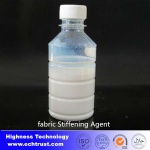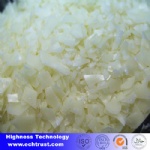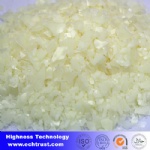Name: AL
E-mail: info@echtrust.com
Add: Guanlin Town ,Yixing City,Jiangsu PR,China

|
Product name : creasing resist finishing agent
Product No. : 20161014164236
|
| Details: | ||||
Lubricants-- crease resist finishing agent L173
Product Description
Crease inhibitor and lubricant for dyeing and scouring process.
Property
1.has lubricating properties.
2.prevents crease formation in dyeing of fabrics made of acryl, wool, wool blends, polyamide, silk and cellulosic knit goods
3.prevents crease formation in milling wool-containing fabrics
4.reduces felting of wool containing qualities in dyeing
5.does not foam and may, therefore, be used on all dyeing machines including jets
6.shows good compatibility with anionic and cationic dyestuffs
7.does not retard dyes
8.avoids moiré in beam dyeing machines
9.prevents chanelling of dye liquor in dyeing of socks, rope and raw stock
Technical Data:
Application:
I.Washing of fabrics which are sensitive to creasing and felting :
In washing DHK 173 is used in concentrations of 0.5 - 1 g/l. The time of treatment depends on degree of soiling and fabric quality. When using DHK 173 loading of the machine may be increased.
DHK 173 is compatible with anionic and non-ionic surfactants. The product also may be used with solvent-containing surfactants.
Typical washing formula : 1 - 2%L 173 1 - 2%L 105 or DHK 104 1%soda ash, ammonia or DHK 130 20 - 30 min / 40 - 50 °C L 173 also may be used advantageously in washing and deszing of jeans.
II.In milling :
The particular advantage gained from the use of DHK 173 derives from the outstanding properties regarding prevention of crease marks. Fabrics become slippery and soft with DHK 173. Creases, therefore, relocate quickly during running of the machine.
Heavily soiled fabrics are prescoured. In this case, DHK 173 may be added to the scouring bath. Usually, however, it is sufficient to use the product in the milling liquor.
The use concentration in milling is 1 - 2 % on the weight of fabric depending on the sensitivity of the fabrics.
III.Dyeing :
1.Dyeing of Wool :
Addition of 2 % DHK 173 on the weight of fabrics to a dye-bath distinctly reduces the formation of creases. Often, especially when dyeing light fabrics, sewing into tubular form is not required. The fabrics become softer and smoother and felt distinctly less. The fabric appearance stays clear and attractive. In dyeing DHK 173 is added as first auxiliary to the bath. Only then the fabrics are entered. This product is compatible with the usually employed dyestuffs at the corresponding pH-values. All additions, therefore, are given into the same bath.
Stripping and re-dyeing often causes a change in fabric appearance due to the long duration of such treatments. In these instances, DHK 173 provides a distinct improvement due to its smoothing and antifelting properties.
Typical dyeing formula : 2 %L 173 X%acid dyestuff 5%sodium sulfate X%sulfuric, formic or acetic acid, depending on the dyestuff 0.5 - 1.5 %levelling agent 60 - 90 min at boiling temperature
2.Dyeing of pile fabric (corduroy, velours, velvet, plush) :
In dyeing of these fabrics the deformation of pile should be avoided to obtain a smooth fabric appearance. Due to the lubrication and crack-mark prevention with L173, it is much easier to obtain an even and attractive fabric appearance.
To obtain best results, the dry fabrics are wetted with DHK 173. The other dyeing chemicals are added to this bath later.
L 173 is compatible with the dyes usually employed.
Typical dyeing formula for cotton fabrics: 2%L173 0.5 - 2%levelling and penetration auxiliary X%direct dyestuff 5 - 20%sodium chloride or sodium sulfate
60 min / 70 - 90 °C
3.Dyeing of acrylic fibers
The formation of creases and crackmarks in dyeing and during the cool-down after dyeing can be reduced by employing DHK 173.
L 173 is non-ionic and, therefore, compatible with cationic dyes, retarders and levelling agents. Typical dyeing formula : 2%L 173 0.5%non-ionic dispersing agent X%cationic dyestuff 0.5-1.5%retarder or levelling agent 60 - 90 min at boiling temperature Dyeing is carried out as usual. Slow heating and slow cooling is essential for good levelness.
4.Dyeing of cellulosic knit goods
L 173 has given good results in dyeing cellulosic knit goods on the beck and on jets with low liquor to goods ratio. The fabric is preserved and crease mark formation is prevented. The product is compatible with the usually employed amounts of salt and alkali in dyeing with reactive dyes. It does not cause dye retardation.
5.To prevent moiré in beam dyeing,
the goods are padded with 10 - 20 g/l L 173 and wound onto the perforated beam, then dyed as usual. |
| Related Products : |





 zirconiunm chemicals
zirconiunm chemicals









